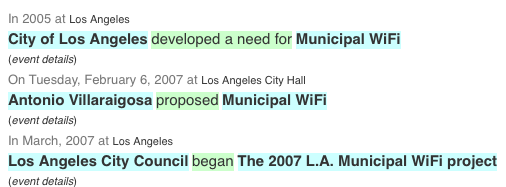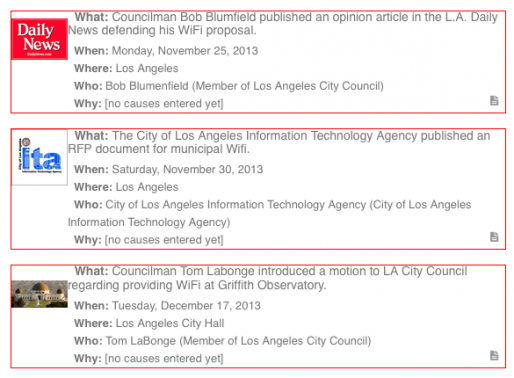Duke University is one of the 2015-16 winners of the Challenge Fund for Innovation in Journalism Education. See all 11 winners and the Honorable Mentions.
Partners
Team
- Bill Adair, Knight Professor of Journalism and Public Policy, Duke University, Project Director, @BillAdairDuke
- Ishan Thakore, Duke student, Reporting Team Lead, @ithakore
- Maxime Fischer-Zernin, Duke student, Research Director, @swissfisch
- David Caswell, creator of StructuredStories.com, Technical Lead, @structstories
- Kio Stark, Senior Producer for Data News, WNYC, WNYC Project Coordinator, @kiostark
- Mark Finlayson, Assistant Professor of Computing and Information Sciences, Florida International University, Adviser on Structured Narratives
Describe your project as a tweet
City hall news, sliced, diced & repackaged for max. accountability: Duke’s StructuredStoriesNYC will test limits of #structuredjournalism
What are you going to test?
We will test the editorial feasibility of using structured journalism for New York state and local government news. Students will use a new platform called Structured Stories to “atomize” the news. Instead of creating traditional news articles, they will write and format sentence-length event descriptions in templates to capture live local news events and organize them into structured narratives. The expected result will be a new form of storytelling; a networked account of local news that accumulates over time and enables the local community to quickly access, query, understand, and contribute to sprawling and complex local government stories.
How will the experiment be conducted?
The experiment will employ student journalists to collect and publish a large body of local government news as structured journalism and to develop guidelines for ensuring journalistic integrity and crowdsourcing of structured reporting. The area of focus will be New York City.
Guided by the journalists at WNYC, the team will establish a virtual newsroom staffed by paid student reporters, beginning operations in June 2015. The students will primarily do original reporting and research about news events in New York City, with an emphasis on local government, as well as some state government coverage.
The students will capture news as structured events and narratives using the Structured Stories platform and will continuously publish those narratives as they are reported. Over the project period, a large body of networked structured journalism about government in New York will be accumulated and published. The objective is not breaking news or publishing investigative results, but instead to steadily accumulate day-to-day news into comprehensive networked stories that are very simple for citizens to navigate, understand and use.

The evaluation, use and demonstration of this unique body of journalism is the heart of the project. Students will create and test editorial rules that enable the structured approach to be leveraged through crowdsourcing. We ultimately expect high levels of engagement by relatively small numbers of news consumers, combined with a clear demonstration of structured journalism as a scalable solution to local reporting challenges.
How will you know if it worked or not?
The experiment will have worked if we successfully publish a substantial quantity of local government news as structured journalism at an acceptable level of quality; if we publish our technical and editorial lessons learned; and if we can demonstrate more user engagement and impact over existing news products, via analytics, surveys and interviews. Ultimately, the experiment will have worked if the project contributes a meaningful alternative to traditional news coverage and demonstrates its feasibility in a real news environment.
How is this project unique and innovative?
This project is inspired by Adrian Holovaty’s vision that journalists need to reimagine how they structure news stories. It seeks to demonstrate an entirely new approach to producing and consuming news, based on the structuring of news events and the arrangement of events into stories. The approach uses techniques from narratology and computational narrative. It attempts to combine the flexibility of expression necessary for real-world journalism with the specificity necessary to interconnect and organize journalism as structured knowledge. If successful as a journalistic story form, this technique offers unique new benefits for both consumers and producers of news.
News consumers benefit from the accumulation of news stories as a single structured artifact, erasing the ‘memory hole’ and increasing the efficiency with which consumers achieve understanding of complex stories. The underlying structure of this journalism enables the same news story to be consumed in different forms (e.g. text, slideshows, timelines, cards, etc.), at different levels of detail and in different languages, via sentence-level automated translation. The technique also enables general news to be explicitly queried directly from the story database, and uniquely identifies individual news events on the web, clarifying discussion and enabling mashups, fact-checking, etc.

News producers benefit from the re-bundling of news as a structured network and it can serve as a valuable archive in which news stories accumulate value over time. The approach also offers a mechanism by which professional reporting can be integrated with citizen journalism and automated journalism.
What technology platforms will you use?
The project will use the Structured Stories technology platform, which is in Beta and which the developer, David Caswell, has used to accumulate and publish Los Angeles local government news. Structured Stories has been in development for 18 months and uses the FrameNet semantic framework from UC Berkeley, several open source semantic web knowledge stores and techniques from computational narrative.
The Structured Stories database and platform is hosted in the cloud, on Amazon AWS and Heroku servers, and is delivered via an Application Programming Interface (API). The Structured Stories browser application enables anyone to find and explore the structured journalism in the story database, and also enables registered users to enter and edit structured news events and news narratives. The Structured Stories platform is publicly available at www.structuredstories.com.
There is no off-the-shelf equivalent to Structured Stories, but the platform uses off-the-shelf and open-source components.
How might this experiment change teaching at your school or media practices in your partner’s newsroom?
This experiment will help broaden the scope of the Lab’s work, enlisting more students in hands-on work in innovative news ventures, and engaging them earlier in their academic careers. Allowing students to contribute to the future of journalism is an integral part of the Reporters’ Labs’ work to pair classroom learning with real-work experience, preparing students for a successful career in 21st Century journalism.
Further, the experience gained from this project will have an immediate impact on the pedagogy of Duke’s journalism program, as it constitutes an important use of structured journalism, a relatively new phenomenon. Finally, the platform, the website, the accumulated structured journalism and our analysis of the creative process will be available for future educational and research projects, and will help students at Duke, at other institutions and across the industry build their own projects.
What could go wrong?
There are technical, editorial and product risks associated with this experiment.
This will be the first use of the Structured Stories platform in a newsroom environment and technical or scale-related problems are possible. Technical risk will be mitigated by extensive testing by the team before the project, and by full-time developer support during the project.
The largest area of risk is editorial – the potential for conflict between the usual editorial flexibility of journalism and the constraints imposed by the project’s event and story structure. Such conflict wouldn’t stop the experiment, but it might reduce the impact of the accumulated structured news. Editorial risk will be mitigated by developing clear editorial guidelines and by actively managing editorial issues with dedicated weekly meetings throughout the project.
The third area of risk is uncertainty about the efficacy of the structured journalism product in enabling news consumers to access the accumulated journalism. We must display the content in ways that are engaging to readers and we must market the product. Product risk will be mitigated by constant metrics-driven improvements to the interface and by a small, targeted marketing campaign.
Regardless of risk, this experiment will publish – the platform is already live and journalism will publish as it is accumulated. Major editorial issues will, by definition, be valuable learning opportunities defining the boundary between flexibility of expression and structure. Even if product issues inhibit wide consumption of the news product, the accumulated journalism will enable further product experimentation after the project completes.

